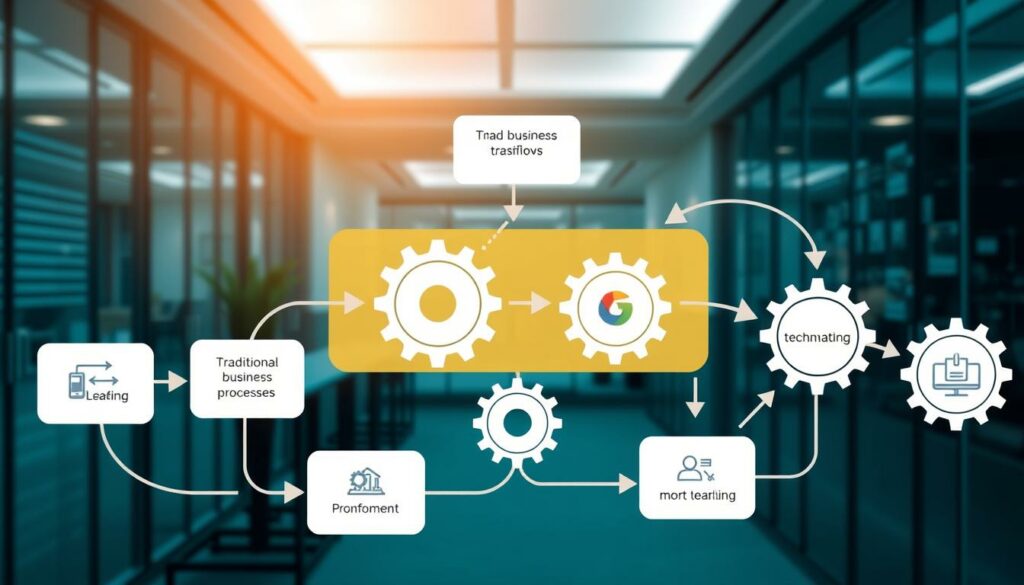In today’s fast-changing business world, business process reengineering (BPR) is key. It’s a strategy for companies aiming to stand out and reshape their niche. Michael Hammer introduced this bold idea in 1990. BPR means totally redoing important business tasks. It favors big leaps in improvement over small steps. Companies adopting this innovation see major gains in business efficiency improvement. They cut costs and greatly improve their performance.
The journey of operational restructuring shines through Ford’s story. They embraced a comprehensive BPR strategy, which led to a 75% cut in their accounts payable department staff. This shows BPR’s power to transform business operations. It dives into the core of process innovation, setting up systems that aren’t just more efficient but ready for today’s business challenges.
Key Takeaways
- BPR is a bold, comprehensive approach to reshape business operations for superior outcomes.
- Ford’s BPR success story remains a benchmark for operational restructuring efficacy, showcasing tangible results and cost efficiencies.
- Conceptualized by Michael Hammer, BPR encourages businesses to discard traditional processes in favor of ground-up redesigns.
- BPR requires an in-depth examination of existing operations, a visionary future state, and rigorous implementation steps to materialize improvements.
- Properly executing BPR can lead to significant benefits, including reduced overhead, enhanced quality, and increased customer and employee satisfaction.
Understanding Business Process Reengineering (BPR)
Business Process Reengineering (BPR) changes the game by aiming for major workflow improvements. Instead of small changes, it pushes for big shifts to increase business efficiency. BPR reimagines frameworks to better match organizational goals, helping companies keep up with today’s challenges.
BPR’s main goal is to greatly improve how things work, from productivity to how happy people are with the results. It involves looking closely at current methods and imagining better ways through process optimization. Many fields where being efficient is key are using these strategies more and more.
To really make BPR work, a big change in how an organization runs is needed. A lot of digital changes don’t succeed because they lack support and people don’t want to adapt. Getting why these human issues happen and dealing with them is as important as the tech side of the change.
| Phase | Key Activity | Objective |
|---|---|---|
| 1. Define Goals | Clarify business objectives & establish KPIs | Align BPR efforts with strategic vision |
| 2. Map As-Is Processes | Document existing workflows | Identify inefficiencies and bottlenecks |
| 3. Design To-Be Processes | Create optimized workflows | Improve efficiency and reduce cycle time |
| 4. Implement & Optimize | Deploy new processes and monitor outcomes | Ensure sustainable business efficiency improvement |
In this era of change, businesses use tools like process mining for better process optimization. By deeply analyzing data, they make sure BPR plans are based on good evidence. This helps in achieving the desired results.
Experts like Hammer and Champy, and newer voices like Davenport and Spanyi, all praise BPR’s benefits. They show that big improvements in how work flows can give companies an edge in different markets.
Taking on BPR can bring big rewards but also faces hurdles such as resistance and the need for a big initial investment. As the business world changes, BPR’s focus on innovation and ongoing betterment is crucial. It helps businesses stay relevant and succeed in today’s quick-moving environment.
Dissecting the Success Story of Ford’s BPR Initiative
The story of Ford’s big change through Business Process Reengineering (BPR) is a great example for others. It shows how making big changes in how things are done can greatly improve business efficiency.
From Operational Overhead to Efficiency Marvel
Ford noticed they had too many people in their accounts payable department compared to Mazda. To fix this, they changed their processes. They used new systems to make things run smoother. This turned a big problem into a success story.
Redesigning for Dramatic Impact
Ford changed how they handled payments and used new technology to make things better. This made processes simpler and improved efficiency everywhere. They started doing transactions online. This let people work on more important tasks. It was a big leap from the old ways.
Assessing the Results: Cost Reduction and Streamlined Workflow
The results of Ford’s BPR show a big win. Here are the key successes:
| Improvement Area | Statistics |
|---|---|
| Cost Reduction | 75% reduction in departmental costs |
| Cycle Time Improvement | 40% decrease in process time |
| Customer Satisfaction | 15% increase in satisfaction scores |
| Productivity Increase | 30% rise post-BPR |
These results show how BPR can totally change a business for the better. Ford’s smart thinking in improving processes led the way in making businesses more efficient.

Strategic Steps for Effective Business Process Reengineering
In today’s fast-moving world, process optimization and business efficiency improvement are key for success. Business Process Reengineering (BPR) is crucial for drastically enhancing business operations. This approach aims at completely redesigning operations for better performance.
At the heart of BPR is examining current methods to find where things slow down. It’s about comparing the current state of operations with the ideal state, and figuring out changes to make things run smoother. Identifying weak spots through gap analysis is also crucial.
- Streamlining operations to improve flow and cut costs.
- Removing unnecessary steps to boost value for the business and its customers.
- Bringing in new tech to automate and upgrade workflows.
Creating a BPR team is a must, consisting of seasoned leaders and project managers. This group ensures redesign efforts meet business goals and fit operational capabilities.
BPR aims at enhancing productivity and resource use, leading to improved efficiency. Enterprise platform solutions play a big role here. They provide tools that fit well with new processes, aiding in growth and lasting improvements.
| Aspect of BPR | Benefits |
|---|---|
| Customer Service Redesign | Better customer satisfaction and experience |
| Operational Efficiency | Less costs and smoother workflows |
| Innovation Encouragement | Setting new standards in the industry |
Setting clear Key Performance Indicators (KPIs) is important for tracking success. This lets businesses tweak their approach as needed to reach their goals. Managing change well is also key to keeping staff morale and productivity high.
Lastly, testing new processes on a small scale first helps identify and fix any issues. This makes rolling out changes less risky. By taking these smart steps, companies can greatly improve their operations. This not only leads to better efficiency but also promotes ongoing innovation and improvement.
The Transformative Impact of Process Optimization
Business Process Reengineering (BPR) is a powerful strategy. It changes how organizations work to improve greatly. By adopting organizational change management, companies can help their teams adjust. This adjustment is key for rethinking how things are done and sparking innovation.
Embracing Organizational Change Management
For BPR to work, managing change is a must. This helps companies change smoothly, making things more efficient and engaging employees better. It requires teaching employees new skills and reorganizing departments. This empowers people and makes the company more flexible. Businesses leading the way do so by encouraging a culture that values new ideas and ongoing improvements. This culture keeps them ahead in a competitive market.
Technological Advancements and Process Innovation
Technology plays a big role in BPR, bringing new ways to excel. Using cutting-edge ERP systems or easy-to-use automation platforms leads to better innovation. This results in higher quality, quicker decisions, and a complete makeover of operations.

With these technologies, companies can make their operations more efficient and focused on their customers. This leads to big improvements in how they function and serve their customers.
Measuring Success Through Improved Business Metrics
To see if BPR is working, you need to track its effects. Companies should use key performance indicators (KPIs) to check. These KPIs help confirm that the changes are boosting efficiency, making customers happier, and improving profits.
| Metric | Pre-BPR | Post-BPR | Impact |
|---|---|---|---|
| Operational Cost | High | Reduced | Decrease in overhead |
| Customer Satisfaction | Low | High | Improved service quality |
| Process Cycle Time | Long | Shortened | Faster turnaround |
| Quality of Output | Inconsistent | Enhanced | Higher standard of products/services |
Companies using BPR see big changes in their processes and profits. This shows the power of smart process innovation and making operations work better.
Business Process Reengineering Versus Process Improvement
The business world is always changing. Because of this, strategies like process optimization, operational restructuring, and process improvement are important. They help businesses work better. But, Business Process Reengineering (BPR) and Business Process Improvement (BPI) are two different methods. They have their own ways and goals.
BPR changes business processes in a big way to get better results. It started in 1990. This method does not use old models. Instead, it builds processes from scratch. By using new technology, it aims for big improvements. This is called Tech-Enabled Re-engineering. It’s used for big changes like mergers or when a company needs to completely change to grow.
On the other hand, BPI makes existing systems better without big changes. Leaders look for small ways to be more efficient. They focus on making small changes to work better and last longer. It’s not about starting over but improving what is already there.
| Aspect | Business Process Reengineering (BPR) | Business Process Improvement (BPI) |
|---|---|---|
| Focus | Radical transformation | Incremental enhancements |
| Initiation | Required during substantial change (e.g., pre/post IPO) | Ongoing adjustments and updates |
| Dependency | Heavy reliance on technology | Reliant on human resource optimizations |
| Outcomes | Sweeping, revolutionary changes | Gradual, consistent improvements |
| Innovation | Introduces new ways of operation | Enhances existing procedures |
| Approach | Clean Slate and Tech-Enabled Reengineering | Preventive maintenance and running repairs |
Choosing between BPR and BPI depends on the company’s needs and future goals. BPR can quickly change a company to meet market needs. BPI, however, is better for steady, long-term improvements without shaking up existing ways of working.
Conclusion
Business process reengineering (BPR) stands out as a powerful strategy for radical change and staying competitive. It starts by looking deeply at a company’s current methods. Then it moves on to a big makeover, focusing on making work flow better and improving processes. BPR is all about changing the way an organization is built, the technology it uses, and its strategy. This is to meet today’s business challenges and what customers need.
Embarking on the BPR journey is not quick or easy. Yet, if done right—through careful planning, doing, and checking—the rewards are huge. Companies see a big leap in how productive employees are and how happy customers are. This gives them a special place in the market. Using BPR, famous names like Airbnb have been able to get rid of unnecessary steps in their work. This makes them more efficient where it counts most. By following BPR, companies have updated how they operate and have become better at meeting today’s high standards.
Still, achieving success with BPR comes with challenges. Everyone in the company must really be on board with the BPR vision. They also need good training and the right technology to make it happen. BPR tells us clearly: to stay ahead, we must analyze deeply, design creatively, and act boldly. And, always put the customer first. As businesses aim to reinvent themselves, using BPR is a key way to offer top-notch, customer-focused services. It helps build a business that lasts and thrives.
FAQ
What is business process reengineering (BPR)?
A: Business process reengineering (BPR) is a way of changing business processes completely. It aims to make big improvements in areas like cost and speed. This concept involves starting from scratch to design processes that work better.
How does BPR differ from traditional process improvement?
BPR is different because it looks for big changes, not just small steps. It doesn’t just improve what’s already there. Instead, it reimagines processes entirely to greatly boost performance.
Can you share a success story of BPR in a real company?
Sure. Ford Motor Company is a great example. They applied BPR in their accounts payable team. This led to cutting their staff by 75%, saving a lot of money and making the department much more efficient.
What are the general steps for implementing an effective BPR approach?
First, you map out current and ideal business workflows. Then, you find gaps between them and choose processes to redo. Next, make a team focused on BPR, redesign the processes, and make new standard operating procedures.
Finally, put these new processes to work everywhere in the business.
Why is organizational change management important in BPR?
Change management is vital because BPR shakes things up a lot. It combines departments and changes jobs. New tech is often used. All this shifts the culture toward being more agile and putting customers first.
How do technological advancements contribute to process innovation in BPR?
Technology, like ERP systems and automation tools, makes processes much better. They help achieve BPR goals such as more quality and faster decisions. This tech is key for streamlining work effectively.
What is the role of metrics in measuring the success of BPR?
Metrics are crucial for seeing how well BPR works. They track performance improvements, how happy customers are, and financial success. These indicators show if the new processes are truly better.
How does BPR fit into the larger picture of operational restructuring?
BPR is at the heart of changing how a business operates. It’s about deep changes, not just small fixes, to align with strategic goals. This can lead to big improvements in how the company performs.
What distinguishes business process reengineering from process improvement?
BPR aims for big, bold changes to fully redo processes. In contrast, process improvement is about polishing what’s already there. It seeks to fine-tune rather than overhaul.



